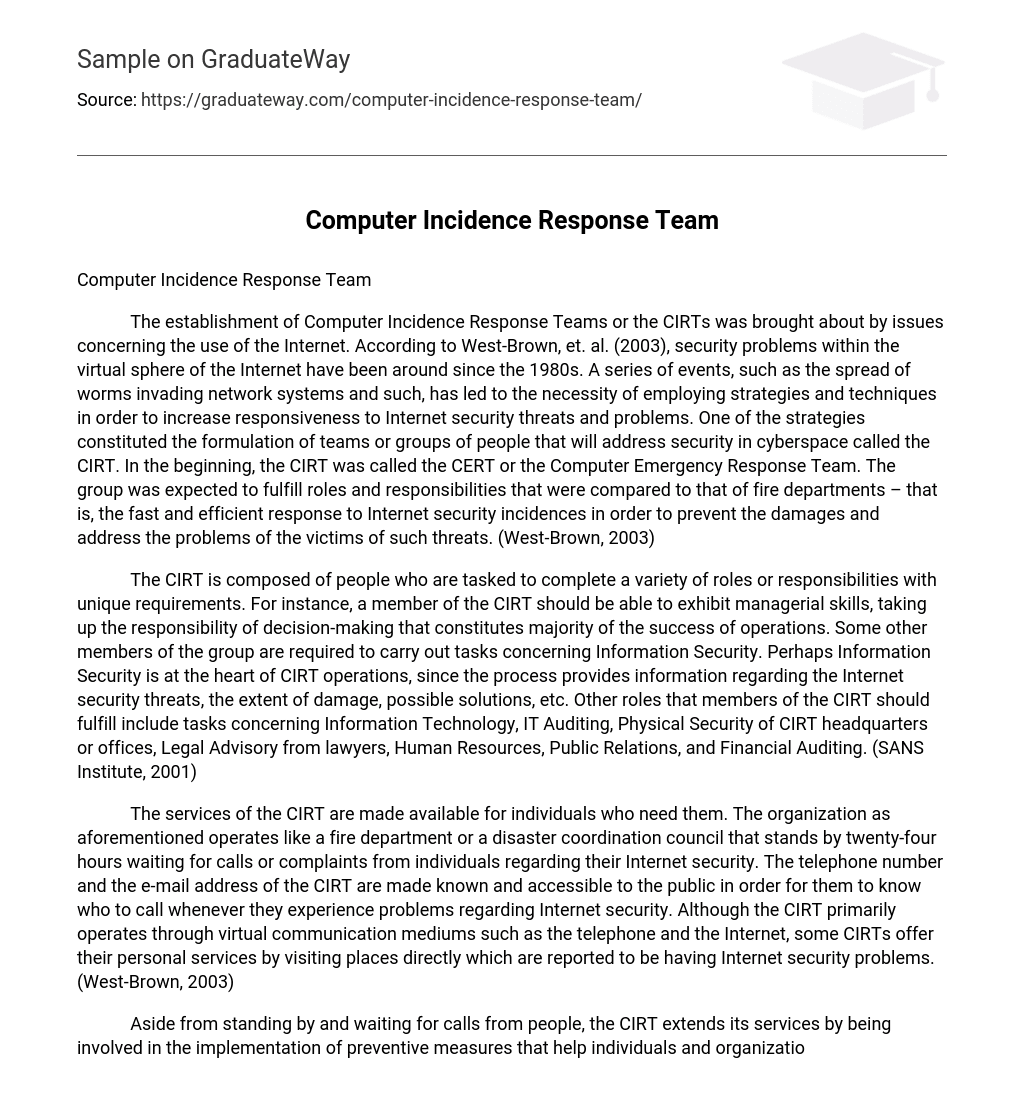The establishment of Computer Incidence Response Teams or the CIRTs was brought about by issues concerning the use of the Internet. According to West-Brown, et. al. (2003), security problems within the virtual sphere of the Internet have been around since the 1980s. A series of events, such as the spread of worms invading network systems and such, has led to the necessity of employing strategies and techniques in order to increase responsiveness to Internet security threats and problems.
One of the strategies constituted the formulation of teams or groups of people that will address security in cyberspace called the CIRT. In the beginning, the CIRT was called the CERT or the Computer Emergency Response Team. The group was expected to fulfill roles and responsibilities that were compared to that of the fire department – that is, the fast and efficient response to Internet security incidences in order to prevent the damages and address the problems of the victims of such threats. (West-Brown, 2003)
The CIRT is composed of people who are tasked to complete a variety of roles or responsibilities with unique requirements. For instance, a member of the CIRT should be able to exhibit managerial skills, taking up the responsibility of decision-making that constitutes the majority of the success of operations. Some other members of the group are required to carry out tasks concerning Information Security.
Perhaps Information Security is at the heart of CIRT operations, since the process provides information regarding the Internet security threats, the extent of damage, possible solutions, etc. Other roles that members of the CIRT should fulfill include tasks concerning Information Technology, IT Auditing, Physical Security of CIRT headquarters or offices, Legal Advisory from lawyers, Human Resources, Public Relations, and Financial Auditing. (SANS Institute, 2001)
The services of the CIRT are made available for individuals who need them. The organization as aforementioned operates like a fire department or a disaster coordination council that stands twenty-four hours waiting for calls or complaints from individuals regarding their Internet security. The telephone number and the e-mail address of the CIRT are made known and accessible to the public in order for them to know who to call whenever they experience problems regarding Internet security. Although the CIRT primarily operates through virtual communication mediums such as the telephone and the Internet, some CIRTs offer their personal services by visiting places directly which are reported to be having Internet security problems. (West-Brown, 2003)
Aside from standing by and waiting for calls from people, the CIRT extends its services by being involved in the implementation of preventive measures that help individuals and organizations avoid experiencing the potential risks and threats of Internet security problems. The CIRT values the dissemination of relevant information regarding the issue of Internet security. Therefore, it acts to great lengths in educating the public about ways in which violations to Internet security are to be prevented. For this purpose, the CIRT completes a collection of files or documents that are presented to the public containing significant information. In addition, the organization also conducts training programs that are structured to help individuals and organizations counter Internet security violations.
Due to concerns regarding privacy issues, the CIRT is unable to monitor Internet processes and operations in order to easily identify Internet security violations such as children who are being threatened or physically harmed by people they meet online. However, through its mission of Internet security awareness through education, the CIRT might help in preventing such incidences from happening and helping out children who might be victims of Internet-related crime by conducting research studies and revealing the results of these studies to the public.
The content of the public report should include advising on how parents should be involved in monitoring the Internet use of their children in order to avoid unpleasant situations and how children should respond to online messages from people they do not know. It is part of the CIRTs responsibility not only to raise awareness and increase knowledge but to also influence vigilance to the public, especially the younger populations. (West-Brown, 2003)
Beyond the mission of the CIRT to influence Internet security awareness through educative processes, the organization is also working on impacting the long-term sustenance of Internet security since it is highly involved in shaping laws and policies being implemented to raise the quality of Internet security standards and improve the regulations that are directed towards violators. The CIRT is also conscious of its role in upholding Internet security standards and policies. To address this goal, the organization is involved in the continuing growth and development through its coordination with other CIRTs and organizations that are concerned with its advocacies as a means to obtain knowledge in improving the kind and quality of services that it provides. (West-Brown, 2003)
The continuing mission of the CIRT will be facilitated through regular communication by its members, from the Director of Safety and Security to the Information Technology specialist, and such. Aside from real-time communication through the Internet from one department to the other, and from one CIRT to another, to facilitate the instantaneous flow of information, particularly during emergencies, CIRTs should conduct meetings in a physical office, perhaps once a month, in order to determine what could be done to improve the services. The meeting should be attended by all CIRTs for the efficient sharing of issues that should be addressed in order to raise the quality of services provided not only by one CIRT but all CIRTs in all areas or regions.
References
- SANS Institute. (2001). Computer Incident Response Team. Retrieved February 10, 2009, from SANS. Website: http://www.sans.org/reading_room/whitepapers/incident/computer_incident_response_team_641?show=641.php&cat=incident
- West-Brown, M. J. (2003). Handbook for Computer Security Incident Response Teams (CSIRTs). Retrieved February 10, 2009, from Computer Emergency Response Team.





